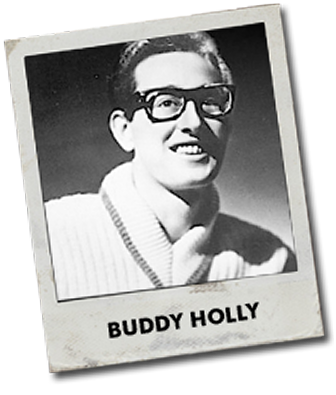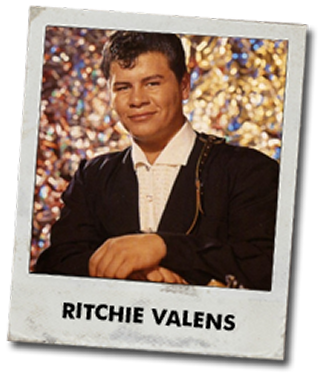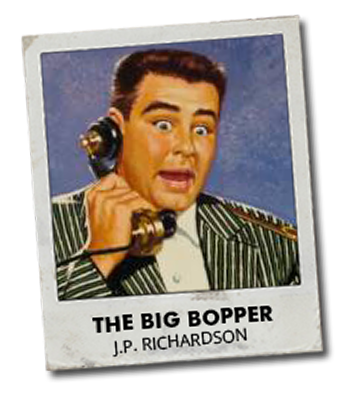BUDDY BIOS
Click on a polaroid to read about the artists
Charles Hardin Holley (September 7, 1936 – February 3, 1959), better known as Buddy Holly, was an American singer, songwriter, and a pioneer of Rock & Roll. The change of spelling of Holley to Holly came about because of an error in a contract he was asked to sign, listing him as Buddy Holly. That spelling was then adopted for his professional career.
Holley was born in Lubbock, Texas. The Holleys were a musical family and as a young boy Holley learned to play the violin, piano and guitar. In the fall of 1949 he met Bob Montgomery at Hutchinson Jr. High School. They shared a common interest in music, and soon teamed up to perform as the duo ‘Buddy and Bob’. Initially influenced by bluegrass music, they sang harmony duets at local clubs and high school talent shows. Holley’s big break came when they opened for Bill Haley and his Comets at a local rock show organized by Eddie Crandall who was also the manager for Marty Robbins. As a result of this performance, Holley was offered a contract with Decca Records to work alone. However, early success as a solo artist eluded him.
Back in Lubbock, Holly formed his own band with drummer Jerry Allison, bassist Joe B. Mauldin, and rhythm guitarist Niki Sullivan – ‘The Crickets’ – and began making records at Norman Petty’s studios in Clovis, New Mexico. Among the songs they recorded was ‘That’ll Be The Day’, which takes its title from a phrase that John Wayne’s character uses repeatedly in the movie, The Searchers. Petty had music industry contacts, and believing that ‘That’ll Be The Day’ would be a hit single, he contacted publishers and labels. Coral Records, a subsidiary of Decca, signed Buddy Holly and The Crickets. This put Buddy in the unusual position of having two record contracts at the same time. Before ‘That’ll Be The Day’ had its nationwide release and became a smash hit, Holly played lead guitar on the hit-single ‘Starlight’, recorded in April 1957, featuring Jack Huddle.
Holly’s music was sophisticated for its day, including the use of instruments considered novel for Rock & Roll, such as the celesta (heard on ‘Everyday’). Holly was an influential lead and rhythm guitarist, notably on songs such as ‘Peggy Sue’ and ‘Not Fade Away’. While Holly could pump out ‘boy-loves-girl’ songs with the best of his contemporaries, other songs featured more sophisticated lyrics and more complex harmonies and melodies than had been previously shown in the genre. Many of his songs feature a unique vocal ‘hiccup’ technique, a clipped ‘uh’ sound used to emphasize certain words in any given song, especially the rockers. For example, the start of the raucous number ‘Rave On’: “We-UH-ell, the little things you say and do, make me want to be with you-UH-ou…”
Holly also managed to bridge some of the racial divide that punctuated rock, notably winning over an all-black audience when accidentally booked for New York’s Apollo Theatre.
After the release of several highly successful songs, in March of 1958, he and the Crickets toured the United Kingdom. In the audience were teenagers named John Lennon and Paul McCartney, who later cited Holly as a primary influence (the band’s name, The Beatles, was later chosen partly in homage to Holly’s Crickets). The Beatles did a cover version of ‘Words Of Love’ that was an almost perfect reproduction of Holly’s version. The Rolling Stones did a cover of ‘Not Fade Away’. The group The Hollies were named in homage.
Holly’s personal style, more controlled and cerebral than Elvis’s and more youthful and innovative than the Country & Western stars of his day, would have an influence on youth culture on both sides of the Atlantic for decades to come, reflected particularly in the New Wave movement in artists such as Elvis Costello and Marshall Crenshaw, and earlier in folk rock bands like The Byrds and The Turtles.
He married Maria Elena Santiago on August 15, 1958. In 1959, Holly split with the Crickets and began a solo tour with other notable performers including Ritchie Valens and J.P. Richardson, ‘The Big Bopper’. One audience member at the tour stop in Duluth, Minnesota, was a young Bobby Zimmerman who would later become known as Bob Dylan.
Following the February 2nd performance at the Surf Ballroom in Clear Lake, Iowa, the performers and their road crew drew straws to decide who would fly in the airplane to the next tour stop, and who would ride in the unheated tour bus. The winners were Holly, Valens and Richardson. The four-passenger Beechcraft Bonanza took off into a blinding snow storm and crashed into Albert Juhl’s cornfield several miles after takeoff at 1.05am. The crash killed Holly (22), Valens (17), Richardson (28), and pilot Roger Peterson (21), leaving Holly’s pregnant bride, Maria Elena Holly, a widow (she would miscarry soon after). Funeral services were held at the Tabernacle Baptist Church in Lubbock, Texas, and Buddy Holly was interred in the City of Lubbock Cemetery.
Holly’s headstone carries the correct spelling of his name, Buddy Holley. It also features a carving of his favourite guitar. Downtown Lubbock has a ‘Walk of Fame’ with plaques to various area artists such as Mac Davis and Waylon Jennings, with a life-size statue of a guitar-playing Buddy as its centrepiece. The Buddy Holly Hall of Performing Arts and Sciences opened in Lubbock in January, 2021.
The tragic plane crash inspired singer Don McLean’s popular 1971 ballad ‘American Pie’, and immortalized February 3rd as “The Day The Music Died”. Contrary to popular myth, ‘American Pie’ was not the name of the ill-fated airplane.
The Surf Ballroom, a popular and old-fashioned dance hall that dates to the height of the Big Band Era, continues to put on shows, notably an annual Buddy Holly tribute on the anniversary of his last performances. The building was added to the National Register of Historic Places in 2011, and in 2021 was named a National Historic Landmark.






